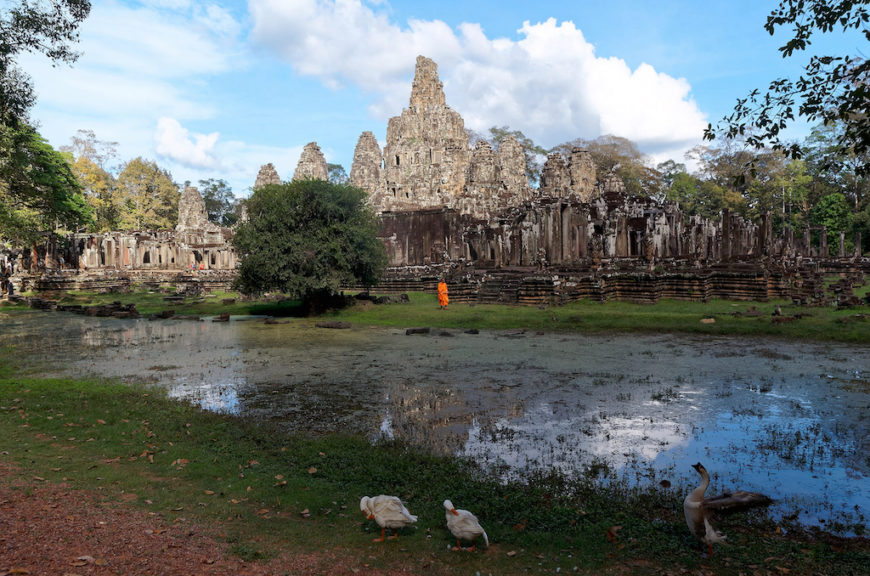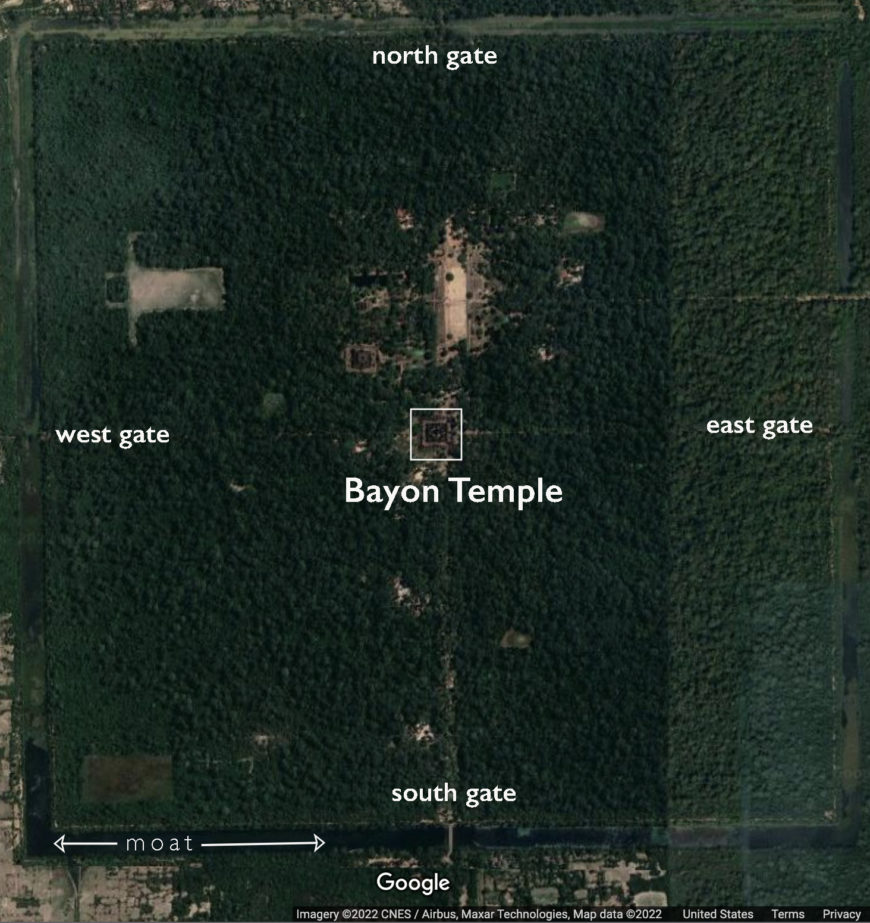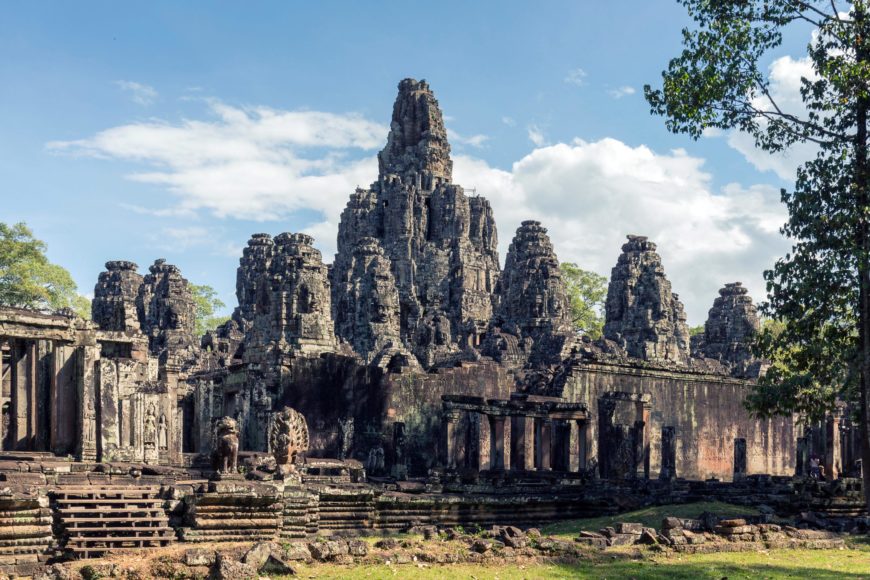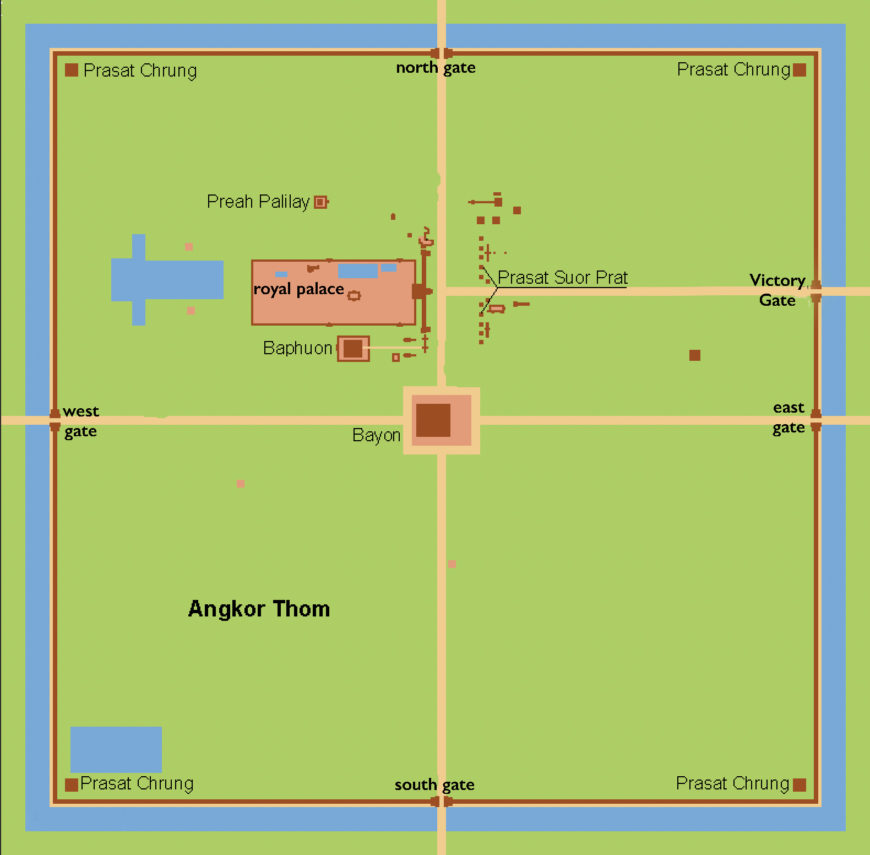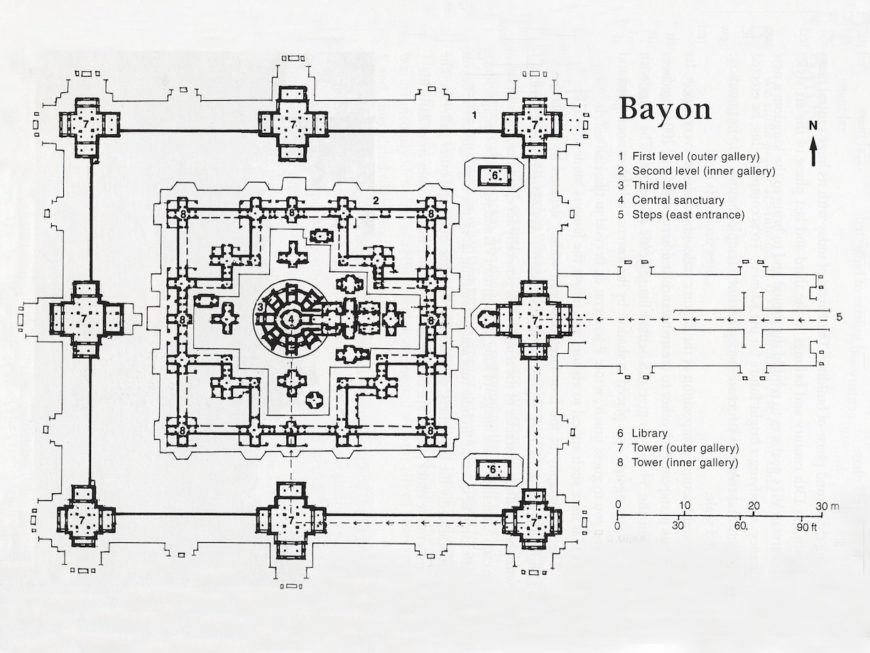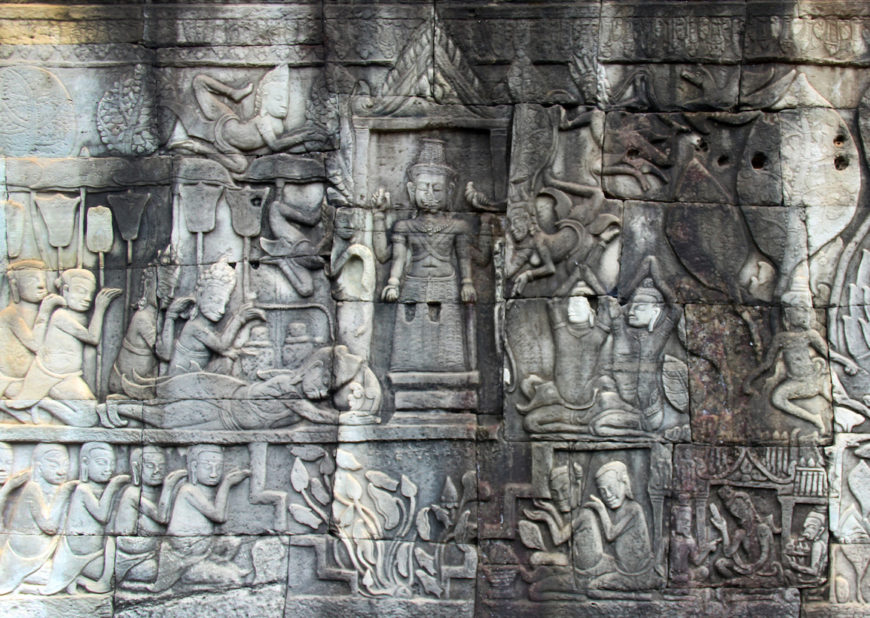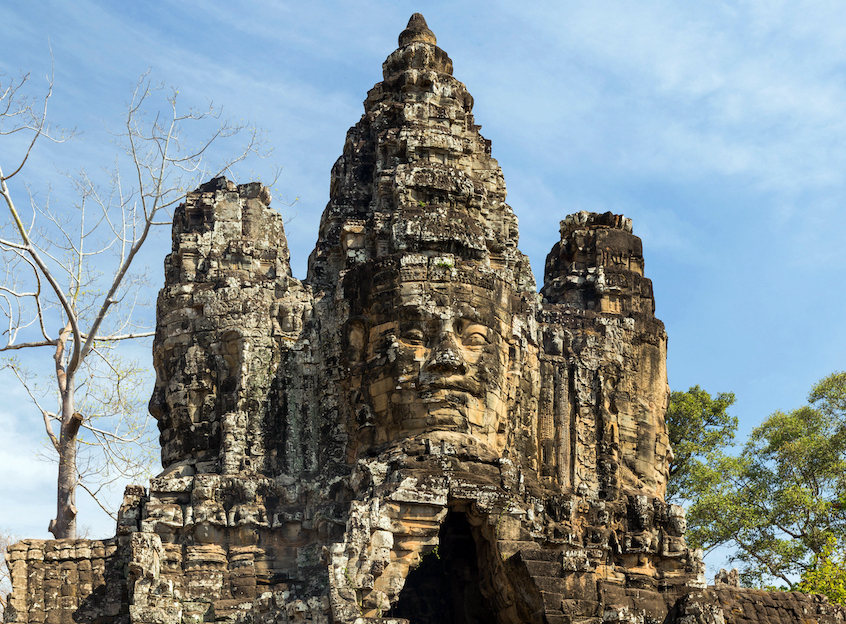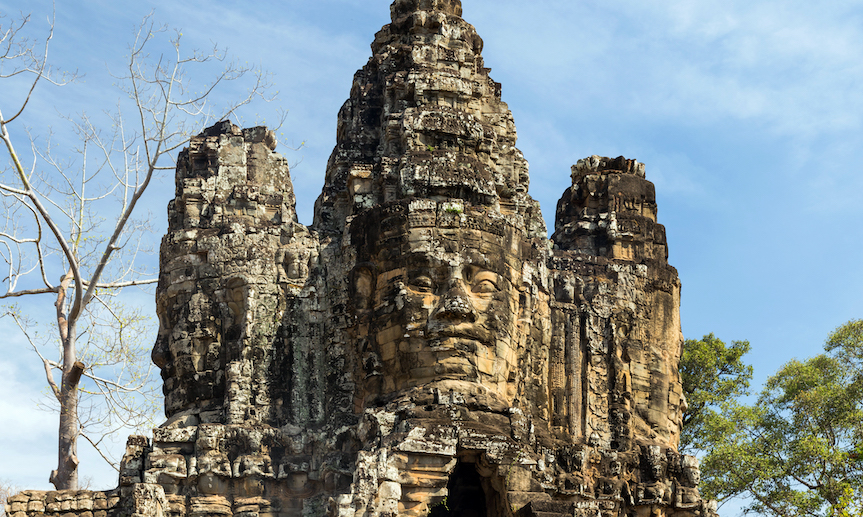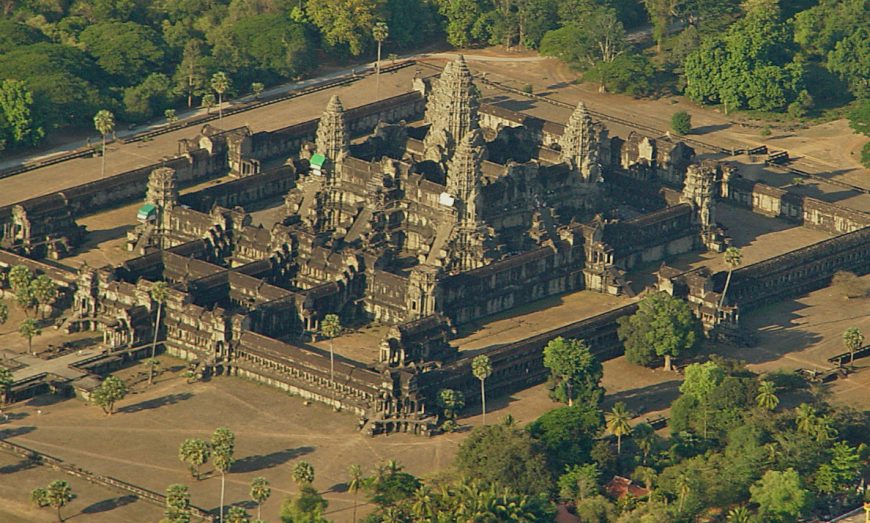There are many reasons why the Bayon Temple is an enigma. The first is the name of the temple, or rather our lack of knowledge of how people referred to the temple during its time of use. Although stone inscriptions, often found at temple sites, dating from the time of Jayavarman VII exist, and provide specific details such as the name and inhabitants of other temples (such as Ta Prohm just outside of the royal city of Angkor Thom), there is no extant documentation for Bayon—the royal city’s most important state temple. [1] The name “Bayon” is a 19th-century French transcription of what early European explorers (such as Charles-Emile Bouillevaux, a Catholic missionary, and Henri Mouhot, a naturalist), heard from their local informants. [2] Bayon likely refers to the Sanskrit term paryanka, which translates to “a pedestal for sacred statues.” [3] According to historian Michael Vickery, the only contemporary inscription that may refer to the temple appears to call it madhyadri or “central mount,” which is a generic term for temples. [4]
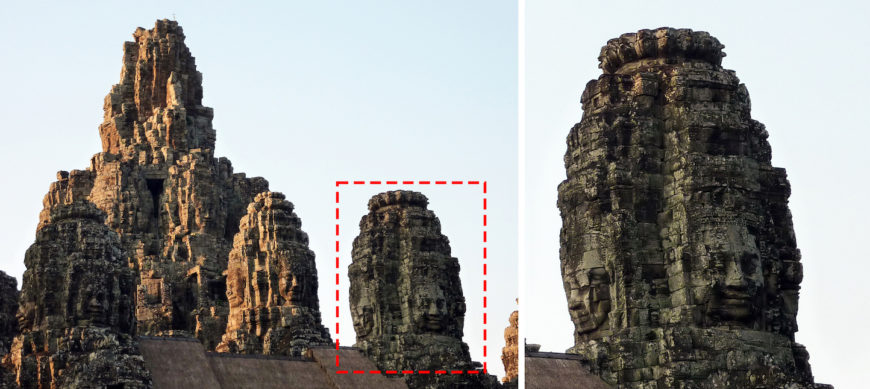
Left: Tower Faces, Bayon Temple, Angkor Thom, Cambodia; right: detail of the tower face in the red square (photo: Photo Dharma, CC BY 2.0)
The mystery over the temple’s name contributes to the enigmatic face-towers that define the temple’s architecture. Since the Bayon’s rediscovery by French scholars and explorers in the 19th century, the identity of the smiling figures that greet visitors to the temple and to the city of Angkor Thom has been debated. Do they depict Buddhist or Hindu deities, or do they depict King Jayavarman VII smiling over his empire? Inscriptions from the temple along with its name could aid in our understanding of the identity of the four-faced figures; however, it has been presumed by scholars that such inscriptions were destroyed by successive rulers who took over Angkor Thom after the death of Jayavarman VII.
The heart of Angkor Thom
The Bayon Temple, which was constructed during Jayavarman VII’s reign, is unique as it is the only Buddhist state temple and the last to be built in the Angkor Empire (also sometimes called the Khmer Empire). While temples continued to be constructed during the Angkor period (9th–15th century), none were on the scale or harnessed the wealth and resources of the Bayon after the death of Jayavarman VII.
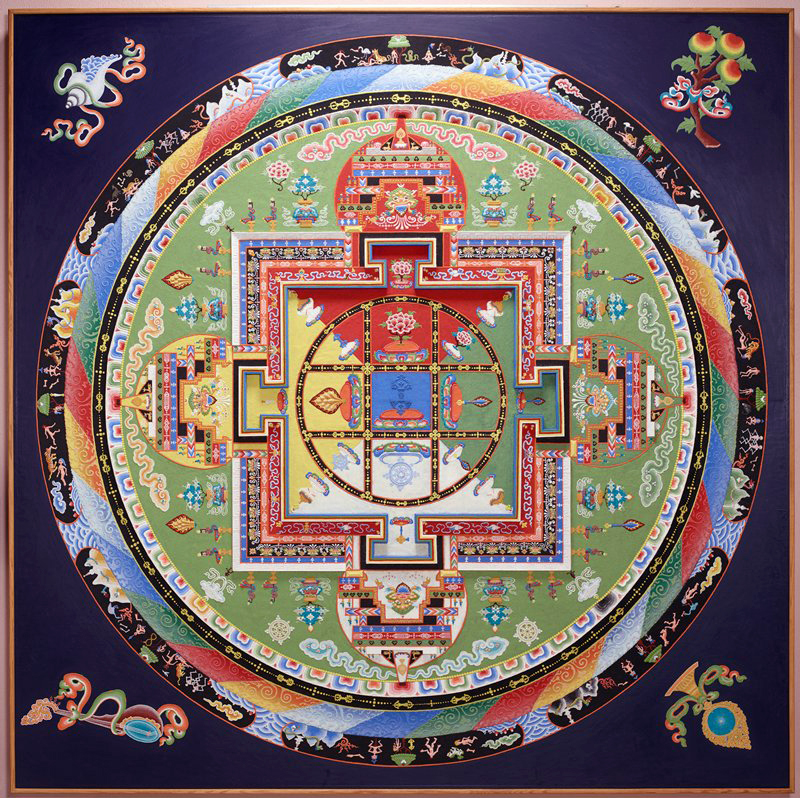
Thangka painting: Monks of the Gyuto Tantric University, Yamantaka Mandala, 1991, colored silicate and adhesive on wood, Tibet (Minneapolis Institute of Arts)
The temple is located at the center of the royal city of Angkor Thom. Unlike other planned cities in Angkor, Jayavarman VII’s royal city was designed as a mandala or cosmic diagram. At the heart of a mandala (utilized by Hindu, Jain, and Buddhist practitioners) is the palace of an important deity or Mt. Meru, which is the center of the universe. Constructed in the heart of Angkor Thom, the Bayon Temple was intended to represent Mt. Meru on earth.
To enter the royal city and gain access to the temple, visitors in the past and present are required to traverse bridges or causeways that pierce the city’s fortified walls. There are five bridges in total, and all but one lead directly to the Bayon. The temple complex is made of sandstone and laterite. While there were originally wooden embellishments and structures that completed the complex, they no longer survive.
The complex itself is built on three levels that are intended to create a mountain-like structure, symbolically and visually linking the Bayon to Mt. Meru. To this end, the complex includes two enclosures (levels one and two) that consist of covered galleries and shrines. At the center of the complex (level three) is the raised cruciform platform that serves as the foundation for the main temple structure, which originally housed the main icon.
The Bayon, as it stands today, does not reflect the original design of Jayavarman VII and his architects. This is because the temple has been added to over the centuries. Angkor Thom was so well fortified that later kings continued to use it as their royal city. While it was common for kings to build a new state temple to reflect their own religious affiliations, Jayavarman VII’s successors found it simpler to remodel the Bayon rather than remove it and build a new temple. [5] This accounts for the appearance of both Buddhist and Hindu imagery at the temple, depending on the religious affiliation of the new king. These later changes further contribute to our lack of understanding of the temple as it is not entirely clear when and by whom such additions were made.
The outer enclosure

Scene showing a marketplace and fortune telling, bas-relief, Bayon, Angkor Thom (photo: on Wikipedia, CC BY-SA 3.0)
The outer enclosure (level one) was constructed during the time of Jayavarman VII, and includes bas-reliefs of daily life in the early 13th century that depict scenes of a marketplace as well as a woman getting her fortune told.
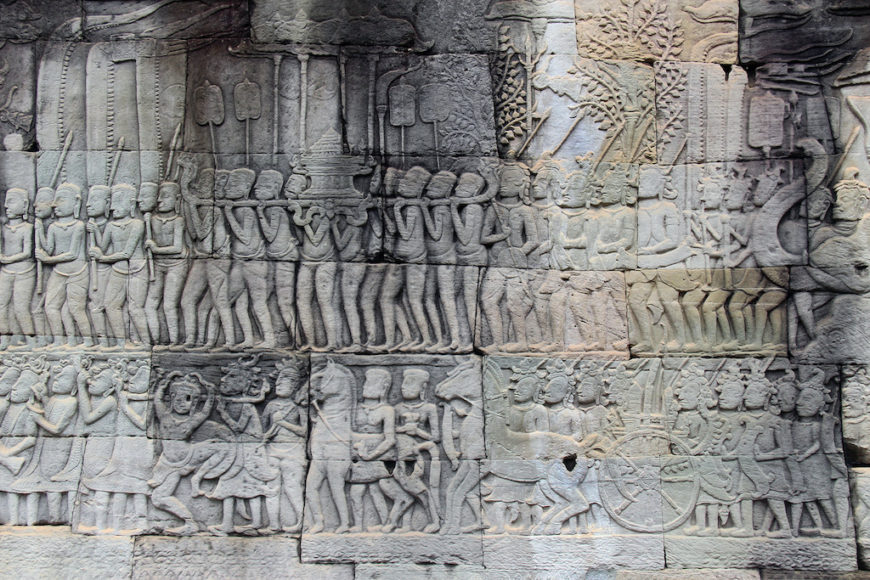
Battle scene, Bayon Temple, Angkor Thom (photo: Gary Todd, CC0)
Historical events such as the Khmer’s battle with the Chams are also found in the galleries of the outer enclosure. These carved reliefs are an important and rare visual document of life in Angkor at this time.
The inner enclosure
The inner enclosure (level two) was built during the time of Jayavarman VII; however, some of the reliefs found in its galleries were likely carved at a later date. This is reflected in changes in artistic style of the carved reliefs as well as the subject matter of the carvings. For example, there is an image of the Hindu God Shiva (in the eastern gallery of the southern section) that was likely added during the reign of Jayavarman VIII who reverted Angkor back to Hinduism.
The many faces of Bayon
The cruciform platform—the third and innermost level of the Bayon—consists of a central tower that is surrounded by eight tangential towers, which are decorated with monumental smiling faces.
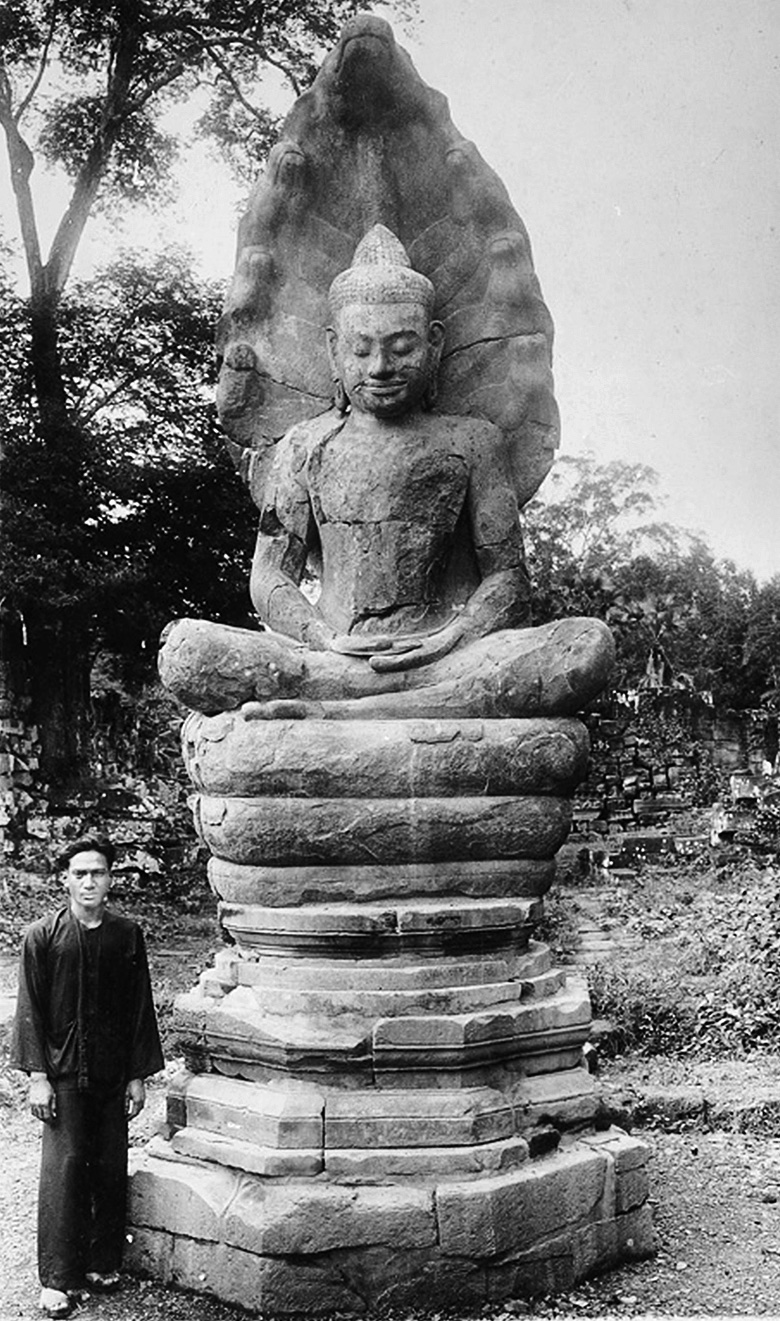
The Buddha seated on the serpent Muchalinda, shown here soon after it was excavated in the early 1930s
The central tower served as the sanctuary of the Bayon Temple and originally housed a monumental sandstone sculpture of the Buddha seated on the serpent Muchalinda.
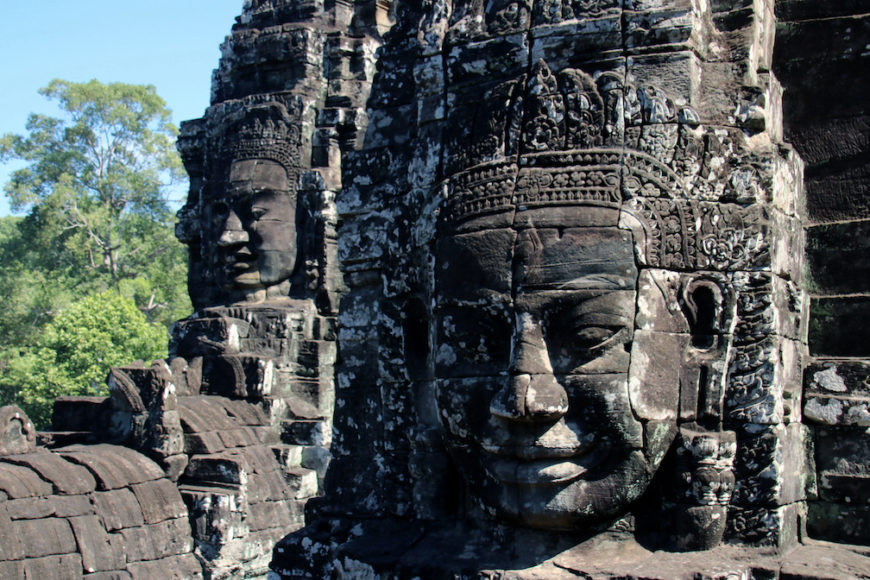
Tower Faces, Bayon Temple, Angkor Thom, Cambodia (photo: Kirk Siang, CC BY-NC-ND 2.0)
The sanctuary is further surrounded by towers and pavilions that are topped with sculptures of three or four-smiling faces. Together, these towers of smiling faces at various heights mimic the peaks of a mountain, reminding the visitor that the Bayon was intended to symbolize the center of the Buddhist universe, Mt. Meru. Today, only 37 face-towers remain in the third level. It is believed that there were originally 49 face-towers; however, the archaeologist Olivier Cunin has argued that there were originally 59 face-towers[6] While the original number of face-towers has more recently been contested, the identity of the smiling faces have perplexed scholars since the 19th century.
Scholars have speculated that the monumental faces that greet visitors at the entrance gates of Angkor Thom and at Bayon represent the Mahayana bodhisattva, Avalokiteshvara; the Tantric, Buddha Vajrasattva; or the Hindu deities, Brahma and Shiva, among others. [7] This is owing to the absence of specific iconography that would help to identify the faces, and our lack of understanding of the particular practice of Buddhism under Jayavarman VII.
The face-towers typically have four faces, each pointed towards the cardinal directions; although, some of the towers at Bayon have three faces. The faces themselves are uniform in style. The smiles are broad, and the eyes are open. The figure wears an intricate filet-style crown, and his elongated earlobes are adorned with inverted lotus jeweled earrings. Because there is no identifying iconography such as the Buddha’s cranial protuberance or Shiva’s third eye, scholars have focused on the multiple faces of the figure to aid in their identification. It is for this reason that early on, scholars associated the figure with the Bodhisattva Avalokiteshvara, who appears in art with multiple faces and who is an important deity in Mahayana Buddhism. However, the faces have also been associated with the multi-faced, Hindu deity, Brahma, who is the Creator of the Universe and who oversees Mt. Meru.
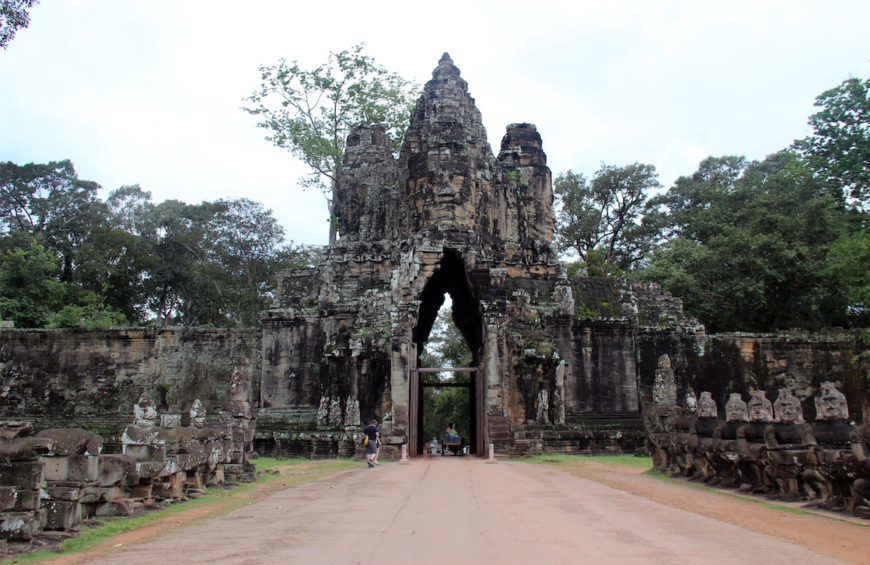
South gate, Angkor Thom, showing the Churning of the Milk balustrade on the left and right (photo: Gary Todd, CC0)
Jayavarman VII was a Buddhist in the Mahayana tradition; however, it is unclear what the particulars of his practice and beliefs were. This is owing to the appearance of Hindu imagery in the city of Angkor Thom, such as the Churning of the Ocean of Milk balustrade leading up to the royal city as well as cult imagery associating himself with the Buddha, and his mother with the Buddhist deity Prajnaparamita (bodhisattva of wisdom and the mother of all Buddhas) and his father with Avalokiteshvara (bodhisattva of compassion).
The mystery of the face-towers and the practice of Buddhism during the time of Jayavarman VII may be our own self-induced puzzle. It is possible that for Jayavarman VII and the people of Angkor Thom, the smiling faces did not represent just one person and that Buddhism was much more multivalent than we are comfortable with acknowledging. As contemporary students, teachers and admirers of Cambodian history and culture, we seek to categorize the various monuments and reigns of the Angkor Period as either Hindu or Buddhist. This helps us to create a linear narrative that has a clear beginning and end. For much of Angkorian history, the empire was ruled by Hindu kings and societal elites who would have also ascribed to Hinduism. Such individuals would not have rejected their faith and their gods outright because King Jayavarman VII established Buddhism as the state religion. The ambiguity and duality of Buddhist and Hindu imagery at Bayon and Angkor Thom may reflect the lived experience and beliefs of contemporary peoples who, like the temple and city, are not so easily categorized.
While the mystery of the smiling face-towers continue to perplex scholars and visitors, it is agreed that the Bayon Temple was intended to represent Mt. Meru on Earth. This is articulated by the face-towers that represent the peaks of the mythical mountain as well as the central location of the Bayon in the royal city of Angkor Thom. During the 13th century, the central tower of Bayon would have been gilded, appearing as a golden mountain at the heart of the city. Although visitors can no longer experience the original splendor of the Bayon, extant architecture and detailed bas-relief sculptures serve as a document of the beliefs and lives of the Khmer people in the 13th century.


